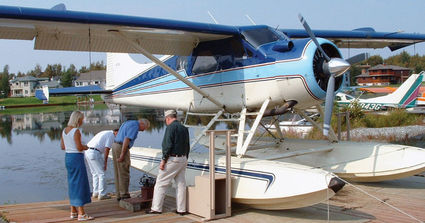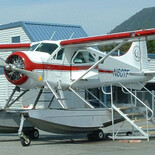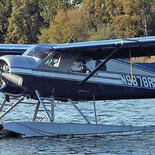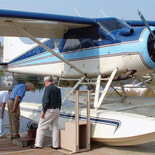I'm dreaming of a Beaver on floats!
Short Flights
September 1, 2018
I think the heat is getting to me as I find myself longing for a little cool! I am daydreaming and looking at all of our photos that we took when we visited Alaska. Ooooo, the image of a Beaver on floats just makes my heart beat a little faster!
This photo shows a de Havilland Beaver taxiing out on Lake Hood in Anchorage, Alaska for takeoff near the Heritage Museum for a "flight-seeing" trip to Portage Glacier, Mt. McKinley or the Chugach Mountains. Beavers are also used to take fishermen into remote lakes for fishing and camping expeditions.
An article I read online nailed the strong feelings of aviators who love the sights and sounds of Alaska and the de Havilland DHC-2 Beaver, when the author wrote: "Among die-hard bush pilots, the mention of the de Havilland Beaver often invokes a religious like reaction. Pilots have been known to take their hats off when one flies over and old-timers have become misty-eyed in remembrance of times past that they had with the de Havilland. With a stout nine cylinder, R-985 horsepower, Pratt & Whitney radial, Beavers fly over emitting a roar reminiscent of steep mountains, unruly bears and true wilderness."
To me that quote says it all for an adventuresome spirit! Beavers are loud and throaty sounding and once inside the aircraft, you can see that this plane was made for getting the job done in the bush.
Bush pilots are a breed of their own and they needed an airplane that fit their personality. From the same online article is this quote, "The Beaver was designed as a serious, no-nonsense bush plane and this philosophy is well reflected in its functional, though rugged cockpit. The Beaver is not a dainty little airplane that appeals to wimps; it is a large, barrel-chested plane, that looks quite capable of eating Cessna's and Super Cub's as mere snacks."
The de Havilland Aircraft of Canada Limited was first incorporated in 1928 to build the Moth aircraft for the training of Canadian airmen, a fragile looking wood and fabric biplane. Later redesignated as the Tiger Moth in 1946, de Havilland Canada designed and built the DHC-2 Beaver aircraft especially to Canadian Bush Pilots specifications. There was a need for a rugged, highly versatile aerial truck which could take off and land almost anywhere, on skis or floats and carry a large half-ton load, plus be consistently reliable. The Beaver was the first short take off and land (STOL) aircraft that de Havilland had ever produced and it remains irreplaceable in the bush plane market today.

Photo provided
Karin & Ron Sheardown, Gen. Joe Ralstan and Al Hansen check out Bill Brook's Beaver on floats in Anchorage, Alaska.
Our dear late friend, Atlee Dodge, in Anchorage made many modifications for the Beaver, including cargo tiedowns and seatbelt attach points, as well as modifications for other bush planes, including the reliable Piper Super Cub.
Over 1,600 DHC-2 Beavers were produced and as a tribute to its popularity and dependability, many of them are still flying and most are fitted with floats. It is rare to find a Beaver on wheels, however, the U.S. Naval Test Pilot School at Patuxent River proudly flies two examples on wheels.
Prices of used Beavers are staggering! Anywhere from $250,000 to $500,000. Prices of wrecked and non-flying restoration projects can be in the low six-figure range. Guess we won't be looking for a Beaver anytime soon, but I can dream, can't I? It is my dream airplane!
See you on our next flight!








